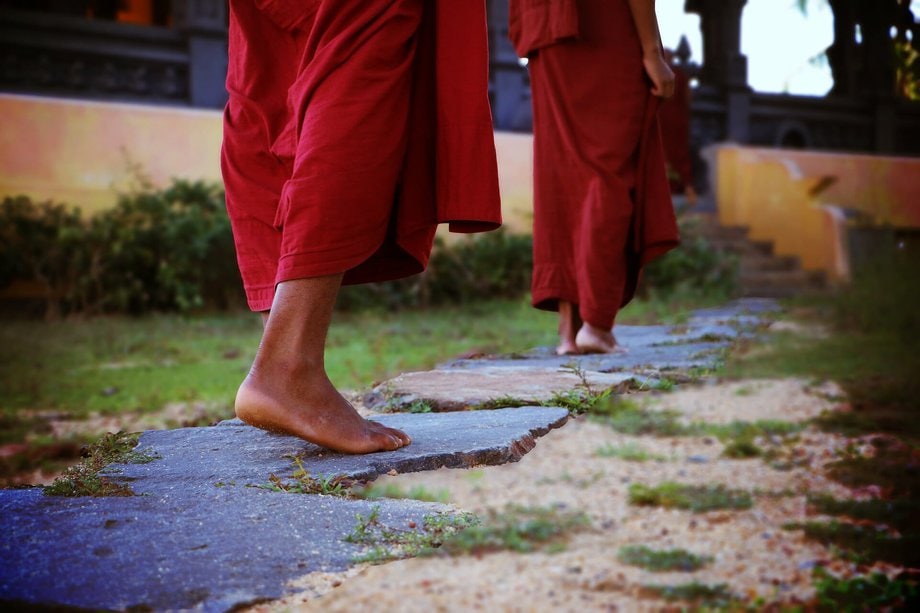Walking Meditation for Stress Relief: Techniques and Practices

Looking for a simple and effective way to relieve stress? Try walking meditation!
In this article, we will explore techniques and practices that can help you find peace and calmness through the act of walking.
Discover the benefits of walking meditation, learn how to choose the right location, and explore breath and body awareness techniques.
By integrating walking meditation into your daily routine, you can cultivate mindfulness and find relief from the stresses of everyday life.
Key Takeaways
- Walking meditation involves walking slowly and mindfully.
- Techniques for beginners include finding a quiet place, taking deep breaths, and paying attention to body sensations.
- Walking meditation cultivates awareness and reduces stress.
- Benefits of walking meditation for stress relief include focusing on sensation of feet touching the ground, breath awareness, body scan, and gratitude walk.
Understanding Walking Meditation
Walking meditation is a practice that involves walking slowly and mindfully to cultivate awareness and reduce stress. If you’re a beginner, there are a few techniques you can try to make the most of your walking meditation.
First, start by finding a quiet and peaceful place to walk, away from distractions. Begin by taking a few deep breaths to center yourself. As you walk, pay attention to your body and the sensations of your feet touching the ground. Notice the rhythm of your steps and the movement of your body.
It’s normal for your mind to wander, but when this happens, gently bring your focus back to the present moment and the act of walking. To maintain focus during walking meditation, you can also try counting your steps or repeating a mantra in your mind.
Benefits of Walking Meditation for Stress Relief
One of the advantages of incorporating walking meditation into your routine is that it allows for a more relaxed state of mind. When practicing walking meditation, you can use various techniques to enhance mindfulness and reduce stress. Here are some techniques you can try:
| Technique | Description | Benefits |
|---|---|---|
| Mindful Steps | Focus on each step, feeling the sensation of your feet touching the ground. | Helps you stay present and grounded. |
| Breath Awareness | Pay attention to your breath as you walk, noticing the inhales and exhales. | Calms the mind and promotes relaxation. |
| Body Scan | Scan your body from head to toe, noticing any sensations or tension. | Increases body awareness and releases tension. |
| Gratitude Walk | Walk with a sense of gratitude, appreciating the beauty around you. | Cultivates a positive mindset and uplifts your mood. |
Choosing the Right Location for Walking Meditation
If you’re looking for the ideal walking meditation spot, you might be torn between urban and natural settings. Both have their advantages and disadvantages, so it’s important to consider a few factors before making a decision.
Factors such as noise level, accessibility, and personal preference can greatly impact your walking meditation experience, so take the time to choose a location that aligns with your needs and goals.
Ideal Walking Meditation Spots
The best places to practice walking meditation for stress relief are often serene natural settings, like parks or beaches. These locations provide a peaceful and tranquil environment, allowing you to fully immerse yourself in the practice.
When exploring scenic trails, you can connect with nature and experience a sense of calmness as you walk. The beautiful views and soothing sounds of nature can enhance your meditation experience and help you relax.
Additionally, creating a walking meditation garden in your own backyard can be a wonderful way to have a dedicated space for your practice. You can design it with elements like beautiful flowers, flowing water, and comfortable seating areas. This personal oasis will provide a peaceful sanctuary where you can escape from the stresses of everyday life and find inner peace through walking meditation.
Urban Vs. Natural Settings
Urban settings can provide a unique backdrop for walking meditation, with bustling streets and vibrant city energy adding a dynamic element to the practice. While natural settings offer tranquility and connection to nature, urban exploration allows you to tap into the energy and diversity of the city. Take a look at the table below to see the different benefits of urban and natural settings for walking meditation:
| Urban Settings | Natural Settings |
|---|---|
| Vibrant energy | Peaceful serenity |
| Variety of sights and sounds | Calming sounds of nature |
| Opportunities for people-watching | Birdwatching and wildlife encounters |
| Cultural immersion | Connection to the earth |
| Sense of community | Solitude and introspection |
Whether you choose to walk through bustling streets or serene forests, both urban exploration and nature therapy can provide a soothing and rejuvenating experience. It’s important to listen to your own preferences and needs, and find the setting that resonates with you the most.
Factors to Consider
Factors to consider when choosing between urban and natural settings for walking meditation include your personal preferences, desired level of stimulation, and the need for tranquility.
Urban settings can offer a vibrant and dynamic environment with bustling streets and city sounds, which may provide a higher level of stimulation if you prefer a more energizing experience.
On the other hand, natural settings like parks or forests can offer a peaceful and serene atmosphere, allowing you to connect with nature and find tranquility.
Consider what type of environment resonates with you and what level of stimulation you need to achieve a meditative state.
Ultimately, the benefits of regular walking meditation practice, regardless of the setting, include reduced stress, improved focus, increased mindfulness, and a greater sense of overall well-being.
Breath Awareness Techniques for Walking Meditation
When practicing walking meditation, it’s essential to use breath awareness techniques to enhance relaxation and reduce stress. By focusing on your breath, you can cultivate mindfulness and connect with the present moment. This allows you to fully experience the sensations of walking, bringing a sense of calmness and peace to your mind and body.
To help you understand the benefits of breath awareness in walking meditation, here is a table that highlights the key aspects:
| Benefits of Breath Awareness in Walking Meditation |
|---|
| 1. Enhances relaxation and reduces stress |
| 2. Increases mindfulness and presence |
| 3. Deepens the connection with your body |
| 4. Improves overall well-being |
Body Awareness Techniques for Walking Meditation
By incorporating body awareness techniques, you can deepen your connection to the present moment during walking meditation. As you move your body in a mindful way, you can enhance your overall meditation experience. Here are some techniques to help you cultivate body awareness during walking meditation:
- Focus on your footsteps:
- Notice the sensation of your feet making contact with the ground.
- Pay attention to the shifting of your weight from one foot to the other.
- Observe any sensations or vibrations as you take each step.
- Tune into your body movement:
- Be aware of the movement of your legs and arms as you walk.
- Notice the subtle shifts in your posture and balance.
- Feel the muscles in your body engaging with each step.
- Engage your sensory awareness:
- Notice any sounds, smells, or textures in your surroundings.
- Observe how your body responds to these sensory inputs.
- Allow yourself to fully immerse in the present moment through your senses.
Cultivating Mindfulness During Walking Meditation
When it comes to walking meditation, there are numerous benefits that you can enjoy.
By engaging in this practice, you can improve your physical health, reduce stress, and enhance your overall well-being.
Additionally, learning techniques for staying present during your walks can help you fully experience the present moment and cultivate mindfulness in your daily life.
Benefits of Walking Meditation
Take a moment to appreciate how walking meditation can provide you with numerous benefits for stress relief. By incorporating this practice into your daily routine, you can experience a sense of calm and relaxation, while also reaping the physical and mental rewards it offers.
Here are some of the benefits you can expect from walking meditation:
- Improved focus and concentration: As you walk mindfully, paying attention to each step and breath, you train your mind to stay in the present moment, enhancing your ability to concentrate and focus on tasks throughout the day.
- Reduced stress and anxiety: Walking meditation allows you to slow down, connect with your body, and release tension. It promotes relaxation and helps to alleviate stress and anxiety.
- Increased self-awareness and mindfulness: By practicing walking meditation, you cultivate a greater sense of self-awareness and mindfulness in your everyday life. This heightened awareness can lead to a deeper understanding of yourself and your surroundings.
To practice walking meditation, start by finding a quiet and peaceful place to walk. Begin by taking slow and deliberate steps, focusing on the sensations in your body as you move. Pay attention to your breath and the feeling of the ground beneath your feet. Allow any thoughts or distractions to come and go without judgment, gently bringing your attention back to the present moment.
Techniques for Staying Present
Now that you know the benefits of walking meditation, let’s focus on some techniques to help you stay present and reduce distractions during your practice.
Staying focused is essential for reaping the full benefits of this mindfulness exercise. One technique is to pay attention to your breath as you walk, feeling the sensation of each inhale and exhale. This will help anchor your attention in the present moment.
Another technique is to engage your senses by noticing the sights, sounds, and smells around you. By fully immersing yourself in your surroundings, you can prevent your mind from wandering.
Additionally, try to let go of any thoughts or worries that arise during your walk and gently bring your attention back to the present moment. With practice, these techniques will help you cultivate a deeper sense of mindfulness and tranquility during your walking meditation.
Integrating Mindfulness Into Daily Life
To make mindfulness a part of your daily life, try incorporating short moments of awareness throughout your day, allowing you to find peace and clarity amidst the busyness of life. Here are some ways to integrate mindfulness into your daily routine:
- Mindfulness in the Workplace:
- Take a few minutes before starting work to focus on your breath and set intentions for the day.
- Practice mindful eating during lunch breaks, savoring each bite and being fully present in the moment.
- Take short mindfulness breaks throughout the day, where you pause and observe your thoughts and sensations without judgment.
- Incorporating Mindfulness into Relationships:
- Practice active listening, giving your full attention to the person you are speaking with.
- Take a moment before reacting to a disagreement or conflict, pausing to observe your emotions and respond with mindfulness.
- Engage in mindful activities together, such as going for a walk or practicing yoga, to deepen your connection and presence with each other.
Integrating Walking Meditation Into Your Daily Routine
If you’re feeling overwhelmed, incorporating walking meditation into your daily routine can provide a much-needed sense of calm and balance. By practicing walking meditation, you can cultivate mindfulness while engaging in physical activity. It allows you to slow down, connect with your body and surroundings, and find inner peace amidst the chaos of daily life.
To get started with walking meditation, it’s important to choose appropriate footwear that is comfortable and supportive. This will ensure that you can walk with ease and focus on the present moment. Additionally, finding time for daily practice is crucial. You can allocate a specific time in your schedule, such as during your lunch break or before or after work, to dedicate to walking meditation.
Here’s a table to help you better understand the benefits and tips for incorporating walking meditation into your routine:
| Benefits | Tips |
|---|---|
| Reduces stress and anxiety | Find a peaceful location |
| Enhances focus and clarity | Maintain a steady pace |
| Improves physical fitness | Observe your breath and body sensations |
Frequently Asked Questions
How Long Do I Need to Practice Walking Meditation to See Results?
To see visible benefits from walking meditation, you need to practice for a consistent duration. The length of time varies for each person, but regular practice over time will yield positive results.
Can I Listen to Music or Use My Phone During Walking Meditation?
Yes, you can listen to music or use your phone during walking meditation. However, it may distract you from being fully present and hinder the effectiveness of the practice in relieving stress.
Is It Better to Practice Walking Meditation Alone or With a Group?
It’s up to you whether to practice walking meditation alone or with others. Both have benefits. Practicing alone allows for personal reflection, while practicing with others can provide support and a sense of community.
What Should I Do if I Feel Self-Conscious or Uncomfortable While Practicing Walking Meditation in Public?
If you feel self-conscious or uncomfortable while practicing walking meditation in public, remember to focus on your breath and the sensations of walking. Let go of any distractions and judgments, and embrace the present moment.
Can I Practice Walking Meditation Indoors, Such as in a Mall or on a Treadmill?
Yes, you can practice indoor walking meditation in places like a mall or on a treadmill. It can still provide stress relief and help you focus on your breath and movement.








